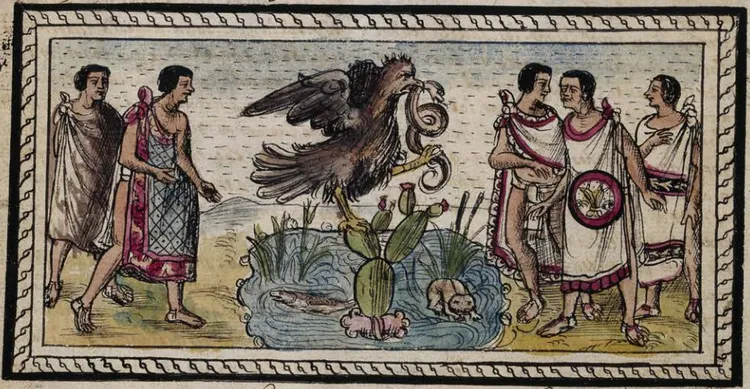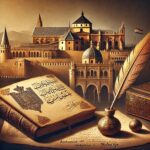The question of the influence of Christianity on Spanish Colonial texts has been a topic of debate for centuries. There is no mistaking that Christianity shaped New Spain in many ways. Nowhere is this more pronounced than the idea of the lost ten tribes in Mesoamerica. By the time the Popol Wuj was translated in the first half of the 17th century, there was already an established belief in the Dominican order that the Kʼicheʼ people were descended from the Lost Tribes of Israel. In chapter 101 of the Theologia Indorum, Vico wrote:
“You are all Israelites who came from there, you are all descendants of the grandsons and sons of Abraham, Isaac and Jacob” (ahiʃrael yx petinak ui yxcamic umam v4ahol Abra(ha)m yʃaac Jacob).”
Later, Francisco Ximenez, who translated the Popol Wuj wrote
“Our Father Fray Domingo de Vico says in chapter 101, of the second part of his Theologia Indorum, that these Indians descend from the ten tribes that were lost to the Jews, and that they did not return to their homeland, and so they preserved for traditions all the events that the sacred text refers to us and the devil was wrapping them up in many errors.”
Ximénez agreed with Vico’s interpretation that the indigenous peoples of the Americas descended from the ten “lost tribes” of Israel, whose deportation from the Kingdom of Samaria after its conquest by Shalmaneser V of Assyria, which is narrated in the second Book of Kings in the Bible. Ximénez references it throughout the Escolios, as well as in his Historia de la Provincia, to explain the origin of Mayan beliefs and the occasional similarity of Mayan stories and Biblical narratives. In Ximénez’s opinion, these moments of overlapping were a matter of failed preservation of a common history. This belief was common not only in the highlands of Guatemala, but throughout Mesoamerica.
Diego Durán who lived in the central valley of New Spain (modern Mexico) also held this view. He wrote in his book History of the Indies of New Spain and the islands of Tierra Firme that:
I confirm my opinion and suspicion that: These natives are from those ten tribes of Israel, which Shalmaneser, King of the Assids, captured and transmigrated from Assyria in the time of Hosea. King of Israel, and in the time of Hezekiah.
This reasoning advocated by many mendicant preachers (both Dominican and Franciscan priests) in New Spain was the result of two beliefs. The first is a millennial worldview. This apocalyptic worldview is that the end of days was near and that Christ would return and usher in an era of peace for a thousand years. This idea was popularized by Joachim di Fiore, a 12th-century Italian theologian. He based his theological idea on passages from the New Testament book of Revelation. For Fiore, the number seven has a particular meaning in the book. Each group of seven “relates to one of the seven main periods of the Church from the birth of Christ to the end of the Christian dispensation.”
In the seventh seal, according to Fiore, there would be peace and the forces of evil would be bound. However, before this could happen, certain events had to occur. These events include the destruction of the Roman Empire, the appearance of the antichrist, and two end-time prophets appearing to combat the antichrist. This apocalyptic approach influenced the Franciscans whose order was started shortly after Fiore’s death. Friars like Jean de Roquetaillade and Bonaventure built on and added to Fiore’s theory. This tradition continued for centuries and was even adopted by Christopher Columbus. Columbus associated the end of the world with the ten tribes. He was influenced by the words of Isaiah chapter 12 verses 11 and 12 which declared
And . . . Jehovah will again stretch out his hand a second time to recover the remnant of his people, whoever is left, from Assyria, from Egypt, from Pathros, from Cush, from Elam, from Shinar, and from Hamath, and from the islands of the sea. Y . . . he gathers the exiles of Israel and gathers the scattered of Judah from the four corners of the earth.
It is difficult to determine when and where this belief began within the Franciscan order, but this idea was already being debated in other mendicant orders at the time of Columbus’ third voyage in 1498. Bartolomé de la casa wrote in response to the use of Isaiah by of Columbus that “since Isaiah was a prophet, he might well have been prophesying the discovery of the New World.”
Because of Fiore’s setting, the Franciscan friars were looking for signs of the second coming. When Protestantism began in Europe, many Franciscans saw this as the sign they were waiting for. Garry Sparks explains
For many observant Franciscans, the “discovery” of the Americas in the early 16th century allowed them to move away from what they understood to be a corrupt European church. Thus, Mesoamerica at the beginning of the 16th century, according to them, was the place and time for the establishment of the purely “spiritual” or “primitive” Church, led by those who honored the vows of strict poverty: the third and last church before the second coming of Christ.
The fulfillment of Isaiah’s prophecy to reunite the ten lost tribes of Israel became a central tenet of the Franciscan millennial worldview. Believing that the second coming was imminent, the Franciscans searched for the people who were actually the ten lost tribes. They saw the indigenous population as that same people. Conversly, the second reasoning defended by mendicant preachers came largely from the Dominican order.
This was the result of a linguistic theory of analogy based on the teachings of Saint Thomas Aquinas. Analogy in the Thomistic sense is both a mode of speech and a basic metaphysical concept, functioning as a mean between two extremes. Aquinas uses analogy to describe the resemblance between things. To illustrate this further, we can look at the word “Good”. If we say that the man is good and a sweater is good, we cannot say that the sweater is good in the same way that a man is good. The quality of a good sweater describes the good in one way, and a good man in the moral sense is another concept. However, both are good in the analogous sense. This theory is based on the notion that God is the cause of everything that exists. According to Aquinas, if God is the cause of everything that exists, then the effects must resemble the cause in some way. If things in the world are good, this must reflect in some way, however imperfectly, the good of God.
This theory of analogy led the Dominican friars to look for similarities between Mayan religion and customs and Christianity. For if God created all men and taught them his commandments, then any departure from the Christian religion must be due to apostasy. Therefore, the Dominican friars looked for similarities within Mesoamerican customs and religions. This theory of analogy was transmitted from Thomas Aquinas to the Dominican friars through Francisco de Vitoria at the University of Salamanca.
When Domingo de Vico began studying at the University of Salamanca, it was already a center dedicated to Thomism, the philosophical school that emerged as a legacy of the work and thought of Saint Thomas Aquinas (1225-1274). Although the Spanish scholastics were primarily theologians, the topics they discussed went far beyond the confines of theology and even theology’s traditional philosophical companions, such as metaphysics and logic. This is partly because Dominican theologians had to comment on Thomas Aquinas’ Summa Theologiae with all the different topics it covered. The fifteenth and sixteenth centuries saw a revival of Thomism in Paris, Rome, and Salamanca.
Francisco de Vitoria, who studied in Paris, adopted this Thomistic revival when he began teaching in Salamanca in 1524. Although the University of Salamanca was not a new foundation, Vitoria and his disciples, especially Domingo de Soto (1494-1560) and Melchor Cano (1509-1560), transformed it into a center for a revived scholasticism, applying Thomism to practical problems such as the evangelization of the indigenous populations of the New World and the legality of slavery. They affirmed the rights of the indigenous people and criticized the increasingly violent actions of the conquest based on the fact that they were not savages but analogous to the Christians. Vitoria worked to limit the type of power that the Spanish Empire imposed on the original peoples, arguing that “The aborigines undoubtedly had a real domain in both public and private affairs, just like the Christians.” Vitoria then used the analogy to try to convince the Spanish empire to stop its inhumane practices against the indigenous population of Mesoamerica.
Domingo de Vico and many of his Dominican contemporaries who studied at the University of Salamanca used this theory of analogy in their duties to convert the indigenous populations. When assigned the responsibility of writing a theology for the indigenous population, Vico drew on his training in analogy in the Thomistic tradition that he had learned at the University of Salamanca and “explicitly turned to Mayan myth and religious discourse in his theological compendium for his K’iche’ audience.” Therefore, analogy also served as a basic way to negotiate understandings between cultures and establish proportional meanings between languages.
Because of his training in the school of Salamanca, Domingo de Vico was educated in the tradition of Thomism, and specifically in the theory of analogy of Saint Thomas Aquinas. This led him to see the Kʼicheʼ Mayan people as a remnant of the lost ten tribes, a people who had once possessed the true knowledge of the Christian gospel but had fallen into apostasy and needed to be restored to their true Christian faith and not to the idolatrous religion into which they had fallen. With this understanding, Vico reused Mayan language, poetry styles, and literary structures to communicate the Christian Bible to the Kʼicheʼ Mayan people in a way that would show a common root of beliefs shared between the Kʼicheʼ Mayans and Christianity.
This strategy was equally used by friar Diego Durán and Bernardino de Sahagún in the central Mexican Plateau. Although Sahagún was a Franciscan friar, he was trained at the University of Salamanca and trained in the humanism of St. Thomas Aquinas. There he learned the linguistic theory of analogy that was so widely used in the Mayan Highlands and employed these same methods in his interpretations of Aztec belief. Diego Durán, despite not knowing much about his education, also seemed to have been influenced by analogous interpretation. Durán was of the Dominican order, and his works often try to connect indigenous practice and Christian belief.
It’s easy to understand why some might think there is a connection between Christianity and Mesoamerican beliefs because of the writings of these Spanish priests. However, because of the apocalyptic worldview of the Franciscan order and the interpretation of analogy by the Dominican order, we cannot afford to take these interpretations at face value. They must be viewed through the lens of 16th and 17th-century thoughts and purposes.





